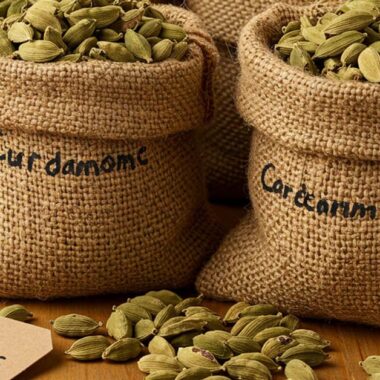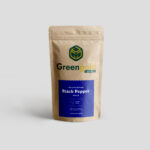Cardamom farming requires careful pest and disease management to ensure healthy plants and high yields. Various insects, fungi, and bacterial infections can affect cardamom plants, leading to reduced quality and production.
Here’s a guide to the most common pests and diseases in cardamom farming and how to control them effectively. ✅🌱
🐛 1. Common Pests in Cardamom Farming
🦟 1.1 Cardamom Shoot & Capsule Borer (Conogethes punctiferalis)
Symptoms:
- Boreholes in shoots and capsules 🟤
- Premature capsule drop 🍂
- Drying of affected shoots 🌾
Control Measures:
✅ Use Pheromone traps (Heli-lure) to attract and trap adult moths.
✅ Spray Neem Oil (5%) or Bacillus thuringiensis (Bt).
✅ Apply Chlorantraniliprole 18.5% SC at early infestation stages.
🐜 1.2 Cardamom Thrips (Sciothrips cardamomi)
Symptoms:
- Silvery streaks on capsules and leaves ✨
- Small, distorted cardamom pods 📉
- Heavy infestations lead to shrivelled pods 😞
Control Measures:
✅ Apply Beauveria bassiana (biological control).
✅ Spray Neem-based pesticides (Azadirachtin 300 ppm).
✅ Use Imidacloprid 17.8% SL or Thiamethoxam 25% WG if infestation is severe.
🦗 1.3 Root Grubs (Basilepta fulvicorne)
Symptoms:
- Wilting plants due to root damage.
- Grubs feed on roots, leading to poor growth.
- Yellowing leaves and stunted plants.
Control Measures:
✅ Apply Metarhizium anisopliae (fungal bio-pesticide).
✅ Drench soil with Neem Cake (500 kg/ha).
✅ Use Chlorpyrifos 20% EC as a soil drench if infestation is high.
🦟 1.4 Cardamom Whiteflies
Symptoms:
- Sticky honeydew on leaves 🍯
- Sooty mold growth on leaves reducing photosynthesis.
- Yellowing leaves and stunted growth.
Control Measures:
✅ Introduce natural predators (ladybugs, lacewings).
✅ Spray Neem Oil (2%) or Beauveria bassiana.
✅ Use Acetamiprid 20% SP for chemical control.
🍄 2. Common Diseases in Cardamom Farming
🌿 2.1 Cardamom Mosaic Virus (Katte Disease)
Symptoms:
- Yellow streaks on leaves with mosaic-like patterns.
- Stunted growth and poor flowering.
- Spread by aphids & infected planting material.
Control Measures:
✅ Use virus-free saplings for planting.
✅ Remove and burn infected plants to prevent spread.
✅ Control aphids with Neem Oil (3%) or Imidacloprid 17.8% SL.
🍄 2.2 Rhizome Rot (Pythium & Phytophthora Fungus)
Symptoms:
- Soft, rotting roots with foul smell.
- Yellowing & wilting of leaves.
- Affects cardamom plants in waterlogged soil.
Control Measures:
✅ Improve drainage to prevent waterlogging.
✅ Apply Trichoderma viride (bio-fungicide) to the soil.
✅ Drench with Copper Oxychloride 50% WP or Metalaxyl 8% + Mancozeb 64% WP.
🍄 2.3 Cardamom Leaf Spot Disease (Colletotrichum gloeosporioides)
Symptoms:
- Dark brown spots on leaves.
- Leaves dry up and fall prematurely.
- Reduces photosynthesis and yield.
Control Measures:
✅ Spray Bordeaux mixture (1%) or Mancozeb 75% WP.
✅ Maintain good air circulation around plants.
✅ Apply Trichoderma harzianum for fungal control.
🍂 2.4 Damping-Off Disease (Fungal Rot in Seedlings)
Symptoms:
- Seedlings wilt and die suddenly.
- Brown, water-soaked lesions on young plants.
- Common in nurseries & waterlogged soils.
Control Measures:
✅ Drench soil with Copper Oxychloride (0.2%).
✅ Apply Pseudomonas fluorescens (biological control).
✅ Ensure proper drainage & avoid overwatering.
📌 Best Pest & Disease Management Practices for Cardamom
✅ Use disease-free planting material.
✅ Apply organic mulches to maintain soil health.
✅ Use Neem Cake (500 kg/ha) & Bio-Fertilizers.
✅ Rotate crops to break pest life cycles.
✅ Install yellow sticky traps to monitor flying pests.
✅ Avoid waterlogging and keep fields clean & weed-free.
🛒 Get the Best Idukki-Grown Cardamom!
For pesticide-free, hand-picked premium Idukki cardamom, choose organic, high-quality products! 🌿✨
👉 Shop Now 🛍️💚
🌟 Conclusion
Managing pests and diseases in cardamom farming requires a combination of organic, biological, and chemical methods. By using preventive measures and sustainable practices, farmers can protect their crops and maintain high yields. 🌿🔥












